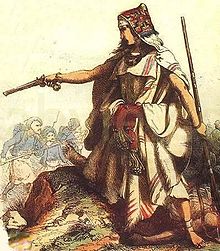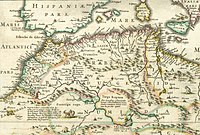Lalla Fatma N'Soumer
You can help expand this article with text translated from the corresponding article in Italian. (October 2012) Click [show] for important translation instructions.
|
This article includes a list of general references, but it lacks sufficient corresponding inline citations. (December 2016) |
Lalla Fatma N'Soumer | |
|---|---|
Faḍma N'Sumer | |
 "Femme kebaïle" by Henri Félix Emmanuel Philippoteaux, often used to illustrate N'Soumer | |
| Born | c. 1830 |
| Died | 1863 (aged 32–33) |
| Known for | Maraboutic resistance fighter against the French conquest of Algeria |
Lalla Fatma N'Soumer (c. 1830 – 1863) (Kabyle: Lalla Faḍma n Sumer; Arabic: لالة فاطمة نسومر) was an Algerian anti-colonial leader[1] during 1849–1857 of the French conquest of Algeria and subsequent Pacification of Algeria. She led several battles against the French forces, until her capture in July 1857. She was imprisoned until her death six years later. She is an Algerian national hero.
Name
[edit]Lalla, the female equivalent of the Berber word mass, is an honorific reserved for women of high social rank or for holy women.[2] "N'Soumer" means "of Soumer", where Soumer was the village nearest the zawiya of her lineage, the Sidahmed. She sometimes bore the name "Lalla N'Ouerdja". Her birth name seems to have been "Fadhma Si Ahmed Ou Méziane", but she went by Fatma N'Soumer and eventually Lalla Fatma N'Soumer with time.[3]
Biography
[edit]Fadhma Si Ahmed Ou Méziane was born around 1830 to Sid Ahmed Mohamed and Terkia n'ath Ykhoulaf[4] in what is now the commune of Abi Youcef, near Aïn El Hammam. As her last name suggests, she descended from the lineage of a respected marabout, Ahmed Ou Méziane, which gave her more influence than most women of Algerian society of the era. Her family would extend to 8 children: 5 brothers and 2 sisters.[4] Fadhma's father was the head of a madrasa (Islamic school) linked to the zawiya of the Rahmaniyya order of Sufi Islam, originally founded by Sidi M'hamed Bou Qobrine in the late 1790s. As a result, Fadhma had access to more of an education than many children of the era. Around the age of 16–18 and with the approval of her older brother as head of the family after her father's death, Fadhma was put in an arranged marriage with a family cousin, Si Yahia n'ath Ikhoulaf. However, the couple quickly separated; she returned to her religious studies. Out of spite, her husband refused to grant her a divorce, making it impossible for her to remarry.[5]
The territory of her birth and life is loosely called Kabylia, the land of the Kabyle people. The French conquest of Algeria began in 1830, the same year she was born. After successfully capturing Algiers the same year, the French focused on the coastal cities at first; Kabylia is mountainous and not easily accessible, with much of the land dominated by the Tell Atlas range of the Atlas Mountains. Growing French influence from their strongholds on the coast eventually reached the mountains, which saw violent resistance to French attempts to impose their authority there. While many Kabyle tribes and leaders engaged in raids and attacks on French positions and outposts as part of "jihad" before, mainly under the leadership of Mohamed ben Zamoum the region of Kabylia itself was only attacked in the 1830s.
Through the 1830s and 1840s, many Kabyle tribes (such as the Igawawen or the Iflissen Umellil) swore allegiance to the emirate of Mascara led by Emir Abdelkader, which's goal was to liberate and establish a modern Algerian states, these tribes would be defeated and the region of Kabylia penetrated in 1846-48. In 1849, a young Fatma entered the resistance and rallied to the cause of Si Mohammed El-Hachemi, a marabout who had waged an insurrection in the Dahra Range since 1847. There, she met Sherif Boubaghla, another Algerian rebel from the western region of Saida who would be another leader and ally in the following years. In 1850, Sherif Boubaghla started an anti-French rebellion in the Babor Mountains. A local assembly of Soumer, the tajmâat, also rebelled. They delegated leadership of the volunteer soldiers to Sidi Tahar (Fatma's brother) and Fatma herself, perhaps leading to the time when she began going by Lalla Fatma N'Soumer. The Soumer-focused rebellion was in the Djurdjura region of the Tell Atlas, and drew from several villages in the area such as Illilten.
In mid-1854, a French incursion led by Charles Joseph François Wolff came to near N'Soumer's villages. The Battle of the Sebaou River then occurred at the Sebaou River near Aïn El Hammam.[6] N'Soumer's forces were able to repel the French; allied cavalry led by Sherif Boubaghla were able to harass the retreating French, but French superiority in cavalry ensured they made their escape.[7] The surrounding villages remained independent. Boubaghla was said to be quite taken with N'Soumer and to have obtained permission from her brother to court her, but her husband continued to refuse to grant a divorce, so the two stayed merely friends.[6]
Another force led by Marshal Jacques Louis Randon arrived in the summer. The French were able to inflict significant damage along their line of march but were counterattacked by N'Soumer and her allied militia in skirmishes.[8] The two sides fought a more decisive battle at the Battle of Tachekkirt, where Boubaghla and N'Soumer's forces emerged victorious.[9][1] After the battle, the French and Kabyle came to terms and agreed to a ceasefire that would last for some years. Sherif Boubaghla died shortly afterward in late 1854, however, which raised Fatma N'Soumer and her brother in station as the leaders remaining.
The ceasefire eventually fell apart. Another French expedition was launched in 1857, led by General Patrice de MacMahon and Marshal Randon. In June 1857, Marshall Randon broke off and defeated a Kabyle village, occupying Aït Iraten following the Battle of Icheriden.[10] Meanwhile, N'Soumer's forces fought a French detachment at the Battle of Chellata Pass; outnumbered and outgunned, they were defeated, and the area around modern Illoula Oumalou was secured.[11] The remnants of Fatma's forces formed up in the hamlet Takhlijt Aït Aatsou, near the Tirourda Pass. However, it was over; while there may have been some fighting, the Kabyle surrendered to the French.
| History of Algeria |
|---|
 |
On 11 July 1857, Fatma was arrested by General Joseph Vantini ("Yusuf"), as were several of her brothers as well as other prominent Kabyle leaders. She was taken to Marshal Randon's camp and was imprisoned in the zawiya of El-Aissaouia, at Tablat.[1] She was then placed under house arrest under the guard of Si Tahar ben Mahieddine. She died there in 1863, at the age of 33, afflicted by her incarceration and likely discouraged by the news of the death of her brother from disease in 1861.[12] The other Kabyle leaders were eventually forced to surrender, and the French strengthened their control over the region.
Legacy
[edit]



Various legends spread about N'Soumer. Her disciples said she was gifted powers by God, including the abilities to see the future and cure illness.[13]
The French explorer and writer Émile Carrey met with N'Soumer after her capture in 1857, and is one of the most important literary sources on N'Soumer. He wrote that she was beautiful, but overweight, and her size was the butt of jokes by the soldiers. He remarked that her capture was still remarkably effective; he wrote that "once she was in our hands, all resistance ceased, and our success was assured."[14] The French also called her "La Jeanne d'Arc du Djurdjura" as a reference to Joan of Arc's role as a female religious and military leader; according to tradition General Yusuf gave her the title.[15]
Lalla Fatma's grave remained a place of pilgrimage for the inhabitants of the region for some time. Her ashes were transferred in 29 October 1994 from the cemetery of Sidi Abdellah, near the zawiya Boumâali in Tourtatine, to Martyrs Square at the El Alia Cemetery in Algiers for notable national figures.[1]
Her life has been documented in the movie Fadhma N'Soumer, directed by Belkacem Hadjadj and released in 2014. The lead role of Fatma N'Soumer was played by French actress Laetitia Eido.[16][17]
In Algeria, a few statues of Lalla Fatma are on display, and a few schools and streets bear her name, notably a mixed-gender high school in Tablat, the city where she died.[citation needed]
References
[edit]- ^ a b c d Akyeampong, Emmanuel Kwaku; Jr, Professor Henry Louis Gates (2012-02-02). Dictionary of African Biography. Oxford University Press. p. 23. ISBN 978-0-19-538207-5.
- ^ Benramdane, Farid (December 1999). "Espace, signe et identité au Maghreb. Du nom au symbole". Insaniyat / إنسانيات. Revue algérienne d'anthropologie et de sciences sociales (in French). 9 (31). Centre de recherche en anthropologie sociale et culturelle: 1–4. doi:10.4000/insaniyat.8250. ISSN 1111-2050.
- ^ Lacost-Dujardin, Camille (2005). Dictionnaire de la culture berbère en Kabylie (in French). Paris: La Découverte. pp. 323–324. ISBN 2-7071-4588-2.
- ^ a b Oussedik 1986, p. 7–8
- ^ Oussedik 1986, pp.10–11
- ^ a b Oussedik 1986, p. 33–34
- ^ Oussedik, Tahar. Bou-Beghla : L'homme à la mule, ENAG édition, Reghaïa, 2006, p. 50.
- ^ Oussedik 1986, p. 35–40
- ^ Illuminating the Darkness: Blacks and North Africans in Islam - By Habeeb Akande
- ^ Kateb, Kamel (2002). Européens, "indigènes" et juifs en Algérie (1830-1962) : Représentations et réalités des populations. Paris: INED. p. 45. ISBN 2-7332-0145-X.
- ^ Kamel, Kaci. Illoula Oumalou : la bataille du col de Chellata commémorée
- ^ Oussedik 1986, p. 75–77
- ^ "Imperialism in North Africa". Women in World History: Module 9. Center for History and New Media. Archived from the original on 18 September 2015. Retrieved 25 August 2017.
- ^ "Voici la fin de la campagne contre la Kabylie : Extrait d'une correspondance – Alger 21 juillet 1857". Journal des débats politiques et littéraires. Paris. 27 July 1857. p. 2.
Le lendemain on lui rendit la liberté mais du moment où elle est entre nos mains, toute résistance cessa, et notre succèss fut assuré.
. - ^ Oussedik 1986, pp. 3, 66
- ^ Carnet de bord du film "Lalla Fadhma N’Soumer", de Belkacem Hadjadj
- ^ Lesme, Anthony (3 January 2018). "Laëtitia Eïdo, actrice à la lisière de plusieurs mondes et bâtisseuse de paix" (in French). TV5Monde. Retrieved 9 January 2018.
Sources
[edit]- Carrey, Émile. Récits de Kabylie. Campagne de 1857, Paris 1858
- Hanoteau, Adolphe. Poésies populaires de la Kabylie du Jurjura, Paris 1867
- Oussedik, Tahar. Lla Fat'ma N'Soumeur, Entreprise nationale du livre, 1986
- Bitam, Boukhalfa. Fadhma n'Soumer. Une autre lecture du combat de l'illustre fille de Werja, Draa Ben Khedda, Aurassi, 2000
External links
[edit]- (in French) An online biography on Algiers parliament site - (often incorrect and a bit emphatic)[citation needed]
- (in French) An article confronting information on Lalla Fadhma coming from oral and written sources
- (in French) Emile Carrey, Récits de Kabylie. Campagne de 1857, page 280.
- 1863 deaths
- People of French Algeria
- People from Abi Youcef
- Kabyle people
- Algerian women in politics
- Women in 19th-century warfare
- Berber rebels
- Prisoners of war held by France
- Algerian people who died in prison custody
- Algerian nationalism
- Prisoners who died in French military detention
- French conquest of Algeria
- National Heroes of Algeria
